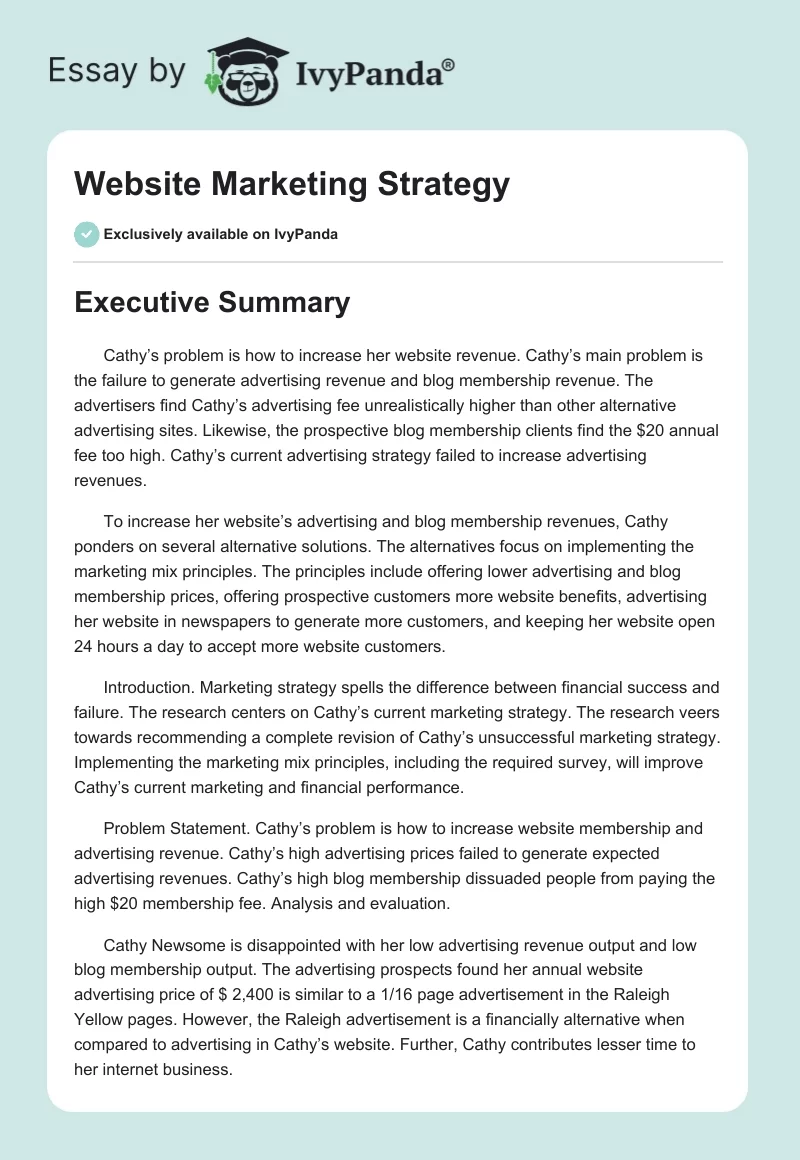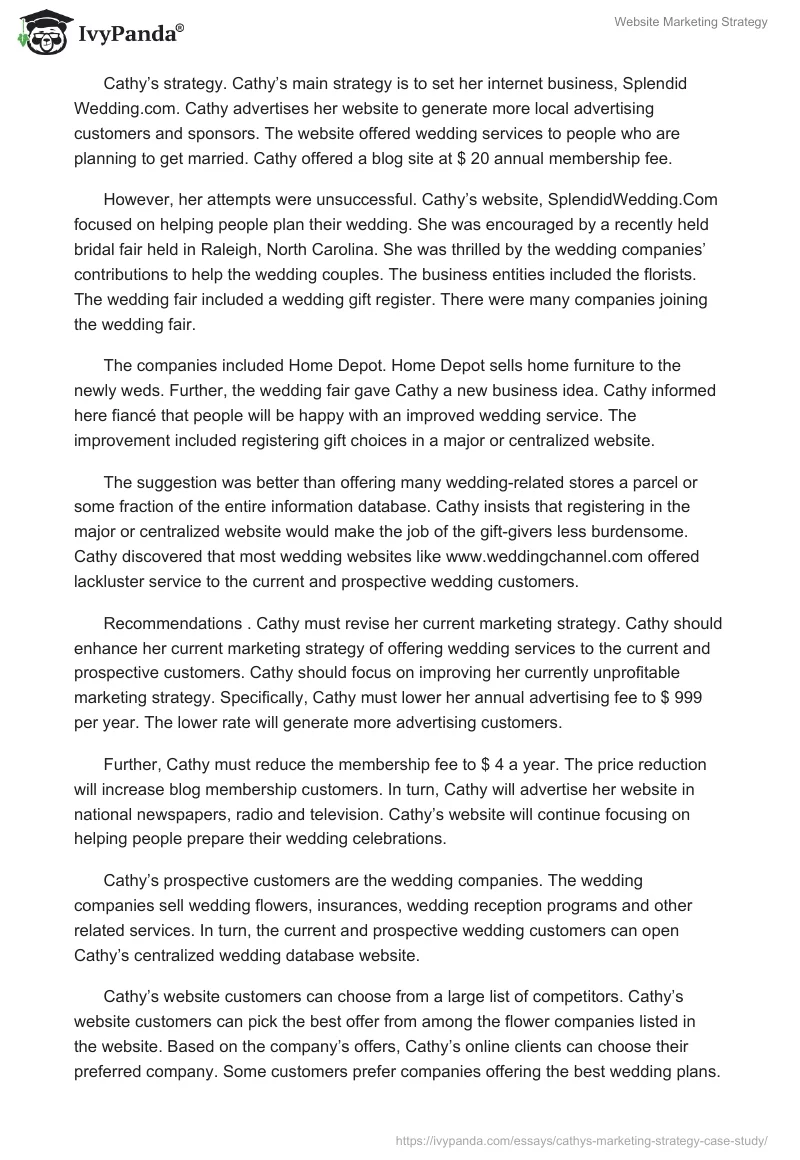Executive Summary
Cathy’s problem is how to increase her website revenue. Cathy’s main problem is the failure to generate advertising revenue and blog membership revenue. The advertisers find Cathy’s advertising fee unrealistically higher than other alternative advertising sites. Likewise, the prospective blog membership clients find the $20 annual fee too high. Cathy’s current advertising strategy failed to increase advertising revenues.
To increase her website’s advertising and blog membership revenues, Cathy ponders on several alternative solutions. The alternatives focus on implementing the marketing mix principles. The principles include offering lower advertising and blog membership prices, offering prospective customers more website benefits, advertising her website in newspapers to generate more customers, and keeping her website open 24 hours a day to accept more website customers.
Introduction. Marketing strategy spells the difference between financial success and failure. The research centers on Cathy’s current marketing strategy. The research veers towards recommending a complete revision of Cathy’s unsuccessful marketing strategy. Implementing the marketing mix principles, including the required survey, will improve Cathy’s current marketing and financial performance.
Problem Statement. Cathy’s problem is how to increase website membership and advertising revenue. Cathy’s high advertising prices failed to generate expected advertising revenues. Cathy’s high blog membership dissuaded people from paying the high $20 membership fee. Analysis and evaluation.
Cathy Newsome is disappointed with her low advertising revenue output and low blog membership output. The advertising prospects found her annual website advertising price of $ 2,400 is similar to a 1/16 page advertisement in the Raleigh Yellow pages. However, the Raleigh advertisement is a financially alternative when compared to advertising in Cathy’s website. Further, Cathy contributes lesser time to her internet business.
Cathy’s strategy. Cathy’s main strategy is to set her internet business, Splendid Wedding.com. Cathy advertises her website to generate more local advertising customers and sponsors. The website offered wedding services to people who are planning to get married. Cathy offered a blog site at $ 20 annual membership fee.
However, her attempts were unsuccessful. Cathy’s website, SplendidWedding.Com focused on helping people plan their wedding. She was encouraged by a recently held bridal fair held in Raleigh, North Carolina. She was thrilled by the wedding companies’ contributions to help the wedding couples. The business entities included the florists. The wedding fair included a wedding gift register. There were many companies joining the wedding fair.
The companies included Home Depot. Home Depot sells home furniture to the newly weds. Further, the wedding fair gave Cathy a new business idea. Cathy informed here fiancé that people will be happy with an improved wedding service. The improvement included registering gift choices in a major or centralized website.
The suggestion was better than offering many wedding-related stores a parcel or some fraction of the entire information database. Cathy insists that registering in the major or centralized website would make the job of the gift-givers less burdensome. Cathy discovered that most wedding websites like www.weddingchannel.com offered lackluster service to the current and prospective wedding customers.
Recommendations . Cathy must revise her current marketing strategy. Cathy should enhance her current marketing strategy of offering wedding services to the current and prospective customers. Cathy should focus on improving her currently unprofitable marketing strategy. Specifically, Cathy must lower her annual advertising fee to $ 999 per year. The lower rate will generate more advertising customers.
Further, Cathy must reduce the membership fee to $ 4 a year. The price reduction will increase blog membership customers. In turn, Cathy will advertise her website in national newspapers, radio and television. Cathy’s website will continue focusing on helping people prepare their wedding celebrations.
Cathy’s prospective customers are the wedding companies. The wedding companies sell wedding flowers, insurances, wedding reception programs and other related services. In turn, the current and prospective wedding customers can open Cathy’s centralized wedding database website.
Cathy’s website customers can choose from a large list of competitors. Cathy’s website customers can pick the best offer from among the flower companies listed in the website. Based on the company’s offers, Cathy’s online clients can choose their preferred company. Some customers prefer companies offering the best wedding plans.
Searching through Cathy’s website, the prospective customers can pick the company offering the best floral designs, floral decoration prices being equal. Lastly, the current and prospective customers can buy an insurance plan offering the most benefits (Fifield, 2012).
To ensure Cathy can move forward, Cathy should spend more time implementing a different marketing strategy (Kerin, R., Peterson, R., 2010). Cathy’s new marketing strategy should include implementing the marketing mix principles. Implementing the marketing strategy, Cathy should price her product reasonably at $999 annual advertising fee and $4 blog membership fee. Cathy will conduct a survey that will serve as the basis for adjusting the recommended $ 999 advertising fee and $ 5 blog membership fee (Fifield, 2012).
Fundamentally, Cathy should offer a high quality website product. The product will cater for the needs of the current and prospective customers. Cathy should conduct a survey to determine the prevailing needs of the community. The survey results will indicate Cathy’s perception of what the wedding couples need may not be all that true. The survey will aid Cathy’s business decisions (Capon, 2007).
Further, Cathy should also offer her website service to the community (place). Cathy is successful in this area of the marketing mix. The prospective customers can easily open her website. The prospective customers can pick their company choices from the home, office, in school, or during a baseball game. He advertising is good (Sandhusen, 2008). Lastly, Cathy should advertise her website in national newspaper to generate more website customers.
Cathy should advertise her website in the television and radio spots. Advertising the advantages of her website in the community newspaper, television, and radio will trigger a higher demand for Cathy’s website. Currently, Cathy’s financial goal does not seem realistic. Her current advertising efforts only produced two customers. The two customers are not enough to generate a profit from Cathy’s website business. To be realistic, Cathy’s current marketing strategy should be revised (Sandhusen, 2008).
Conclusion. Based on the above discussion, implementing marketing strategy will make or break Cathy’s financial and marketing performance. Cathy’s current marketing strategy proved to be financially unsuccessful. Cathy’s current advertising procedure fails to generate more advertising customers and blog membership customers.
Cathy’s only hope to extricate herself from her financial crisis is to immediately implement the marketing mix principles and conduct surveys. The surveys will serve as basis for Cathy’s new pricing schemes.
The principles include lowering the current website advertising price and blog membership price, offering more benefits to customers, advertising the website in newspapers and ensuring Cathy’s wedding website is open 24 hours a day will increase Cathy’s advertising revenues and blog membership revenues. Indeed, Cathy’s setting into motion the marketing mix principles will increase Cathy’s website revenues.
References
Capon, N. (2007). Managing Marketing in the 21st Century. New York: Wessex Press.
Fifield, P. (2012). Marketing Strategy. New York: Routledge Press.
Kerin, R., Peterson, R. (2010). Strategic Marketing Problems. New York: Prentice Hall
Sandhusen, R. (2008). Marketing. New York: Barron’s Press.


